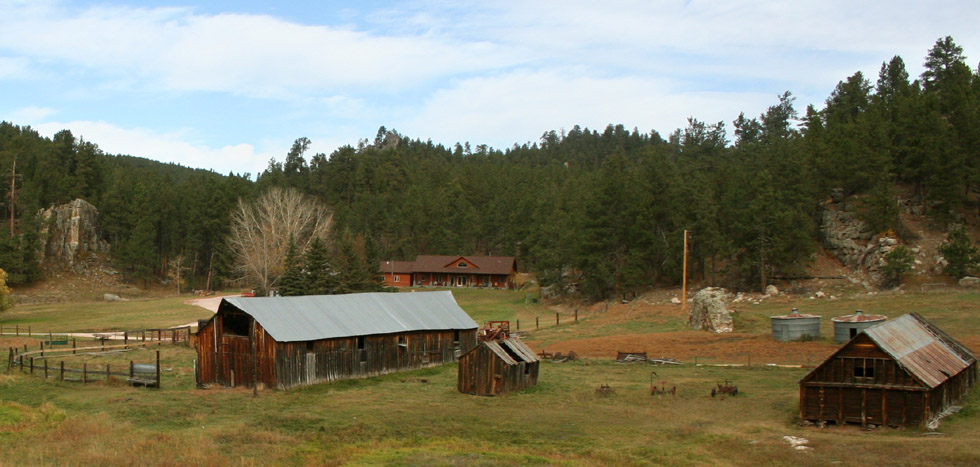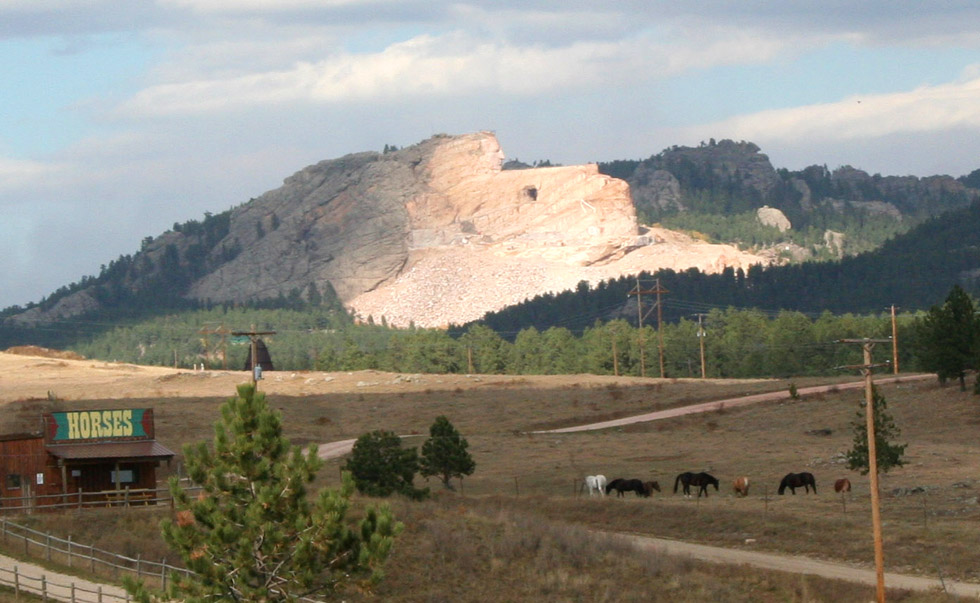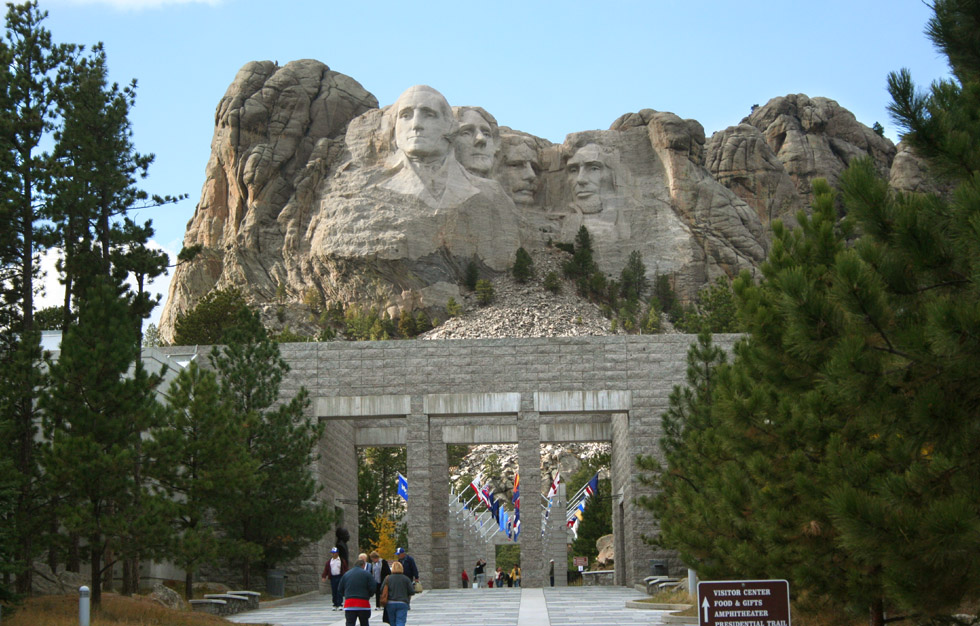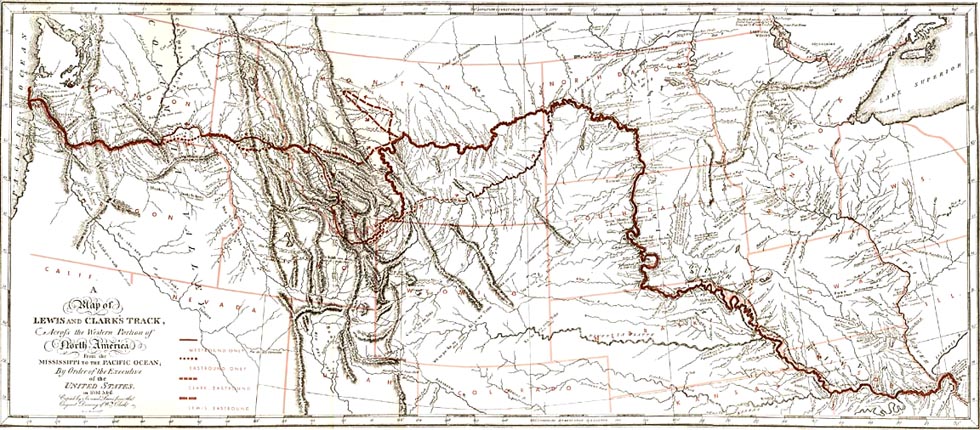|
|
|
| Introduction | October 2007 |
Yet another trip to The Badlands, and the joys of the
near west. This time, I paid a bit more attention to the marvelous Black Hills.
The last of the Indian Wars was fought over this place, and a visit of a few
days, makes the reasons clear. Compared to the heat, and dryness of the
surrounding plains, the Black Hills are a paradise of water, wood, and game. Two of the world's great caves (Jewel Cave, and
Wind Cave) are nestled within these hills. I visited both, on this trip. I also
dropped in on the town of Deadwood, and even gave the famous motorcycle Mecca of
Sturgis a look. On the way out, I stopped to wander through Pipestone, and made
my usual stops at the Mississippi, Missouri, and various other points of
interest.
was fought over this place, and a visit of a few
days, makes the reasons clear. Compared to the heat, and dryness of the
surrounding plains, the Black Hills are a paradise of water, wood, and game. Two of the world's great caves (Jewel Cave, and
Wind Cave) are nestled within these hills. I visited both, on this trip. I also
dropped in on the town of Deadwood, and even gave the famous motorcycle Mecca of
Sturgis a look. On the way out, I stopped to wander through Pipestone, and made
my usual stops at the Mississippi, Missouri, and various other points of
interest.
I have visited, or passed through, this area many times, since my first trip out here thirty years ago; but the place never loses its magic, or runs out of new things awaiting discovery. This is the land of Lewis and Clark, Jim Bridger, cowboys, Indians, trappers, and traders - or it least is was. Even today, though, these are still places of relative freedom, and wide open spaces. There is also amazing variety out here, of people and geography. The forests and woodlands of the east are wonderful, paradise on Earth; but there is a certain similarity to them. the west is different. The lands seems to change, almost by the hour while motoring west. In addition to the climatic changes, man has made a number of changes of his own. Mount Rushmore, as well as Crazy Horse, are the two largest sculptures in the world. Rushmore was the reshaping of a mountain peak, and Crazy Horse is an attempt (as yet far from complete) to reshape an entire mountain. One of the most striking things about this area, is its sense of identity. To call it isolated would be too strong a word, particularly considering the multitude of gaping tourists who wander the roads, and roads of these hills. Still there is a sense of the area being apart from everything around it, immune to the touch and influence of the outside.
 It all seems to start at the Mississippi,
which is the gateway, barrier, the official
demarcation point between the west, and the
original properties of the United States.
The Mississippi was the boundary line
between French, and English portions of the
continent. The whole continent was
considered to be wild; but the French lands were even more so. While the
English, Dutch, and other colonial powers were building cities, settlements, and
farmlands, on the colonial lands east of the Mississippi, the French saw this as
more of an opportunity of a different sort. To the French, these were wild lands
suitable for trapping and trading, but not for settlement. Few large settlements
were built, and the land was left relatively untouched, as was its native
population. Despite the attitude of benevolent neglect, this land would have
been destined to become New
France, except for some problems that
Napoleon was having. There was his expensive
war with England, a self destructing economy, and a nation on the verge of
complete chaos. He decided to rid
himself of his expensive colony, and get some fast cash, by selling the French
lands west of the Mississippi, to President
Jefferson, of the United States, in the
Louisiana Purchase. The rest, as they say,
is history. This one act, more than doubled the size of the fledgling United
Sates, and its settlement, development, and taming would be the work of
generations. It is a job that even today, appears to be far from complete. It is
always fascinating, and rewarding to come and visit this continual work in
progress.
It all seems to start at the Mississippi,
which is the gateway, barrier, the official
demarcation point between the west, and the
original properties of the United States.
The Mississippi was the boundary line
between French, and English portions of the
continent. The whole continent was
considered to be wild; but the French lands were even more so. While the
English, Dutch, and other colonial powers were building cities, settlements, and
farmlands, on the colonial lands east of the Mississippi, the French saw this as
more of an opportunity of a different sort. To the French, these were wild lands
suitable for trapping and trading, but not for settlement. Few large settlements
were built, and the land was left relatively untouched, as was its native
population. Despite the attitude of benevolent neglect, this land would have
been destined to become New
France, except for some problems that
Napoleon was having. There was his expensive
war with England, a self destructing economy, and a nation on the verge of
complete chaos. He decided to rid
himself of his expensive colony, and get some fast cash, by selling the French
lands west of the Mississippi, to President
Jefferson, of the United States, in the
Louisiana Purchase. The rest, as they say,
is history. This one act, more than doubled the size of the fledgling United
Sates, and its settlement, development, and taming would be the work of
generations. It is a job that even today, appears to be far from complete. It is
always fascinating, and rewarding to come and visit this continual work in
progress.
This time I traveled, and mostly slept, in my van. A van is a pretty nice way to travel, and I felt quite at home. I would sit in my big captains chair, with the cruise control set, my slippers on, and my favorite CDs playing in my changer. The cooler between the front seats was filled with good things, and there was great scenery passing by. From time to time, I would stop off, look around, maybe take some pictures, and talk to some people. Every once and a while, I would stop, just to laze around, perhaps fire up the grill, or maybe just loaf on the fold down bed in the back. At night, I would settle in, bury myself in sleeping bags, and read myself to sleep, listening to the hum and chirp of the night insects, and the calls and rustlings of the night animals. The main book that I chose, for the trip was an account of the Lewis and Clark expedition. There were other books with me, of course, but this was the cornerstone.
Lewis and Clark started off from St. Louis, and traveled up the Mississippi, to the Missouri, and then up the Missouri to the Yellowstone area, and beyond, over the mountains, and down through the Columbia Valley. You can still catch a little of that feeling out here, if you are open to the experience. The expedition took over three years, and most Americans were surprised upon its return, having thought the expedition long lost, or destroyed. The primary mission of the expedition was to find a passage from the Atlantic, to the Pacific. To a certain extent, that mission failed. No such passage exists, other than in the polar regions. On the other hand, the primary mission was accomplished, to the extent that it was now known that there was no point in continuing to search for such a passage. Actually, such a passage was found, years latter; but not on the American continent, and certainly not within the boundaries of The United States. A Northwest passage exists, through the Arctic; but it is only open for several months of the year, and is not exactly convenient. Even had the existence of the passage been known, it would have done the nation, and the expedition little good. In any event, the ships of the day would have been unable to use it in any regular practical way. Its discovery, by Henry Hudson and others, along with its exploration is a very interesting story in its own right.

The secondary mission of the expedition was to chart, explore, document, and determine the extent of the new American territories. This mission was accomplished beyond all expectations, and is what the expedition is remembered for. A rough map of the course of the expedition, as well as an outline of the various divisions of the continent, is shown on the map to the left. As can be seen by the map, the United States was the smallest of the divisions, and gave only small indication of the greatness which it would assume. A more inclusive map, showing the entire continent, including the present day areas of Canada, and Mexico, would make the difference even more apparent. even this is not the whole story. For all practical purposes, civilization ended at Pittsburgh, with the Detroit, and St. Louis areas being wilderness settlements with uncertain futures.
In addition to exploring , cataloging, and filling in blank spaces on the map, the expedition began the exploration and settlement of the west, and made available a trained cadre of men, to be the vanguard for those who would stake their futures in the opening of the new western lands. Kit (Alexander) Carson, John Colter, and others became instant celebrities, and authorities on the wilderness, and would lead and influence many an explorer. Within the lifetime of most of these men, the area would be changed beyond all recognition. Cities were built, rails were laid, and homesteads opened up. The vast majority of the Indian Wars were fought here, some of the last having taken place in The Black Hills. The area was divided up into territories, which in their turn became states. Within twenty years of the expedition, New Spain would become independent, and rename itself Mexico, before almost instantly breaking up into warring factions, several of which were gobbled up by the growing United States. Within thirty years, Texas would break away, and eventually become part of The United States. Within sixty years, in 1869, the Golden Spike would be hammered home, marking the completion of the intercontinental railroad. Patrick Gass, the last surviving member of the expedition, died the next year.

I have visited, or passed through, this area many times, since my first trip out here thirty years ago; but the place never loses its magic, or runs out of new things awaiting discovery. This is the land of Lewis and Clark, Jim Bridger, cowboys, Indians, trappers, and traders - or it least is was. Even today, though, these are still places of relative freedom, and wide open spaces. There is also amazing variety out here, of people and geography. The forests and woodlands of the east are wonderful, paradise on Earth; but there is a certain similarity to them. the west is different. The lands seems to change, almost by the hour while motoring west. In addition to the climatic changes, man has made a number of changes of his own. Mount Rushmore, as well as Crazy Horse, are the two largest sculptures in the world. Rushmore was the reshaping of a mountain peak, and Crazy Horse is an attempt (as yet far from complete) to reshape an entire mountain. One of the most striking things about this area, is its sense of identity. To call it isolated would be too strong a word, particularly considering the multitude of gaping tourists who wander the roads, and roads of these hills. Still there is a sense of the area being apart from everything around it, immune to the touch and influence of the outside.
This time I traveled, and mostly slept, in my van. A van is a pretty nice way to travel, and I felt quite at home. I would sit in my big captains chair, with the cruise control set, my slippers on, and my favorite CDs playing in my changer. The cooler between the front seats was filled with good things, and there was great scenery passing by. From time to time, I would stop off, look around, maybe take some pictures, and talk to some people. Every once and a while, I would stop, just to laze around, perhaps fire up the grill, or maybe just loaf on the fold down bed in the back. At night, I would settle in, bury myself in sleeping bags, and read myself to sleep, listening to the hum and chirp of the night insects, and the calls and rustlings of the night animals. The main book that I chose, for the trip was an account of the Lewis and Clark expedition. There were other books with me, of course, but this was the cornerstone.
Lewis and Clark started off from St. Louis, and traveled up the Mississippi, to the Missouri, and then up the Missouri to the Yellowstone area, and beyond, over the mountains, and down through the Columbia Valley. You can still catch a little of that feeling out here, if you are open to the experience. The expedition took over three years, and most Americans were surprised upon its return, having thought the expedition long lost, or destroyed. The primary mission of the expedition was to find a passage from the Atlantic, to the Pacific. To a certain extent, that mission failed. No such passage exists, other than in the polar regions. On the other hand, the primary mission was accomplished, to the extent that it was now known that there was no point in continuing to search for such a passage. Actually, such a passage was found, years latter; but not on the American continent, and certainly not within the boundaries of The United States. A Northwest passage exists, through the Arctic; but it is only open for several months of the year, and is not exactly convenient. Even had the existence of the passage been known, it would have done the nation, and the expedition little good. In any event, the ships of the day would have been unable to use it in any regular practical way. Its discovery, by Henry Hudson and others, along with its exploration is a very interesting story in its own right.

The secondary mission of the expedition was to chart, explore, document, and determine the extent of the new American territories. This mission was accomplished beyond all expectations, and is what the expedition is remembered for. A rough map of the course of the expedition, as well as an outline of the various divisions of the continent, is shown on the map to the left. As can be seen by the map, the United States was the smallest of the divisions, and gave only small indication of the greatness which it would assume. A more inclusive map, showing the entire continent, including the present day areas of Canada, and Mexico, would make the difference even more apparent. even this is not the whole story. For all practical purposes, civilization ended at Pittsburgh, with the Detroit, and St. Louis areas being wilderness settlements with uncertain futures.
In addition to exploring , cataloging, and filling in blank spaces on the map, the expedition began the exploration and settlement of the west, and made available a trained cadre of men, to be the vanguard for those who would stake their futures in the opening of the new western lands. Kit (Alexander) Carson, John Colter, and others became instant celebrities, and authorities on the wilderness, and would lead and influence many an explorer. Within the lifetime of most of these men, the area would be changed beyond all recognition. Cities were built, rails were laid, and homesteads opened up. The vast majority of the Indian Wars were fought here, some of the last having taken place in The Black Hills. The area was divided up into territories, which in their turn became states. Within twenty years of the expedition, New Spain would become independent, and rename itself Mexico, before almost instantly breaking up into warring factions, several of which were gobbled up by the growing United States. Within thirty years, Texas would break away, and eventually become part of The United States. Within sixty years, in 1869, the Golden Spike would be hammered home, marking the completion of the intercontinental railroad. Patrick Gass, the last surviving member of the expedition, died the next year.

Return to the Badlands, and to Minuteman Missile.
| Photos | Comments |
| Starting Out | Over the last few years, I have been crossing the
Mississippi, and getting out to The Badlands, Black
Hills, and other parts of South Dakota nearly every
summer. I have always had a soft spot for this area,
ever since my first journey out here, by motorcycle,
at nineteen. My first stop, of any consequence, is
just across the Mississippi at Dresbach. As often as
I have been here, the bluffs, and the river never
lose their magic. |
| Pipestone | This has been a very special place, for
centuries. This has been the traditional source of stone,
for the making of the ceremonial pipes, sometimes called
peace-pipes, since long before the arrival of Europeans. It
is also, history aside, quite a lovely and peaceful place. |
| South Dakota | This has become one of my favorite places.
The state has the homey feel of the Midwest, the
flavor of the West, the allure of the cowboy, and is
near enough that a week is plenty of time to get out
there and get back. This place is essence of road,
and plainly seduces the motorist. |
| Badlands |
As always, if I am in this part of the country, I
have to stop here for a visit. I generally come here
in the summer; but my first time here was in the
fall. For the first time since my initial visit, I
arrived here during the fall, in October. |
| Black Hills | I never do this area
justice, as many times as I have been out here.
Custer State Park is here, as well as two of the
countries premier caves, and much of it's wildlife. |
| Wind Cave | This is the fourth longest cave in the world, and is unusual in several respects. It is known for it's boxworks, and is one of the few caves in the world to feature this formation. The cave got its name, because it "breathes", through its natural opening/ |
| Jewel Cave | This is the second longest cave in the world, and is has quite a different feet to it, than Wind Cave. This is a much more open cave, with large rooms, and high ceilings. It is also colored somewhat differently, and has only a few of the boxworks which fill Wind Cave. |
| Road to Rushmore | From the underground mazes of the caves, to the sculptures on top of Mount Rushmore, there are roads here, almost without peer in the world. This is why this has become such a popular place for motorcyclists. |
| Rushmore | Been there, done that, seen it before; but how could anyone pass within 100 miles of this amazing monument, and not stop to take a look? |
| Deadwood | The classic cowboy town, well preserved and the genuine article. |
| The way back | Well, all good things come to an end. Still, it
is always nice to get home. The Midwest is paradise. |